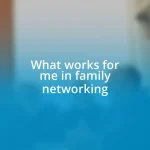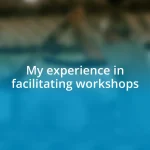Key takeaways:
- Identifying the specific needs and interests of seniors, such as video calling and online shopping, is crucial for creating engaging and relevant workshop content.
- Developing a well-structured workshop agenda that balances instruction, hands-on practice, and social interaction enhances participant engagement and learning outcomes.
- Gathering feedback through surveys and informal conversations helps refine future workshops and fosters a supportive community for ongoing improvement.

Identifying target audience needs
When I first started planning my workshop, I realized that understanding the needs of seniors was crucial. Many of them have had limited exposure to technology, leading to feelings of frustration or anxiety. I remember chatting with a neighbor who shared her struggles with using a smartphone; her story resonated with me deeply and revealed an urgent need for patience and tailored instruction.
It became clear that I needed to provide a welcoming environment where seniors felt comfortable asking questions. I found myself pondering, what would make someone like my neighbor excited about learning? I started considering the specific topics that would spark their interest—things like video calling family and accessing online resources for hobbies. This focus made all the difference.
Through informal conversations, I discovered that visuals and hands-on exercises resonated the most with them. I always aim to create workshops that are engaging and interactive. For instance, during one session, I introduced a simple project where participants created a digital photo album. Seeing their eyes light up when they successfully put together memories was a powerful reminder of why identifying needs is such an essential part of the planning process.

Selecting appropriate technology topics
The process of selecting appropriate technology topics is truly essential to the success of a workshop for seniors. Based on my experience, I discovered that practical topics often generated the most enthusiasm. For instance, I decided to focus on everyday technology applications like online shopping and social media, as these are relevant in their lives. I remember the joy on my aunt’s face when she learned to video chat with her grandchildren; it was like giving her a window into their world.
Additionally, I realized that incorporating familiar platforms made the learning experience less intimidating. During one session, we tackled how to use Facebook to connect with friends and family. It was enlightening to see how eager they were to reclaim connections that had faded over the years. Each topic sparked lively conversations, which not only reinforced their learning but also fostered a sense of community among participants.
To guide my topic selection, I created a comparison table that contrasted the complexity and relevance of various subjects. This helped me visualize how each topic aligned with the interests and capabilities of the seniors. I highly recommend taking the time to analyze topics in this way.
| Technology Topic | Complexity Level | Relevance |
|---|---|---|
| Online Shopping | Medium | High |
| Video Calling | Low | High |
| Social Media Basics | Medium | Medium |
| Basic Computer Skills | High | Medium |
| Online Banking | Medium | High |

Developing an engaging workshop agenda
Crafting an engaging workshop agenda was a journey that required not just structure but also sensitivity to the participants’ feelings. I aimed to blend instruction with moments of joy and connection. It became evident to me that a well-paced agenda, with breaks for discussion and hands-on practice, would keep energy levels high. I remember when one of the participants joyfully exclaimed, “I didn’t think I could learn this!” It was in those moments that I realized how crucial it was to build an agenda that allowed for both learning and celebrating small victories.
Here’s a simple outline of key components I included in my agenda:
- Introduction and Icebreaker: Start with a light-hearted activity to create a comfortable atmosphere.
- Hands-On Demonstrations: Engage participants immediately with real-life examples.
- Interactive Q&A: Encourage questions to ensure everyone feels supported.
- Break Time: Allow time for participants to socialize and absorb the information.
- Group Projects: Facilitate collaboration by having them work together on a task, like setting up a social media account.
- Closing Reflections: Gather feedback and share personal stories of technology impact, deepening connections.
Using this format, I made sure the participants remained engaged without overwhelming them. The smiles on their faces after each session made all the planning worthwhile.

Recruiting knowledgeable instructors or volunteers
Finding knowledgeable instructors or volunteers was a vital step in my workshop planning. I reached out to local colleges and tech enthusiasts, knowing that their expertise would enhance the learning experience. I remember one university student who was eager to help; his excitement was infectious, and I could see how his passion translated into effective teaching.
I also tapped into community resources, like senior centers and local tech clubs. When I shared my vision of the workshop, many individuals spontaneously offered their time. I was pleasantly surprised at how many people were willing to support seniors in learning technology. Isn’t it heartwarming to think about how a simple request can bring people together for a common goal?
Recruiting volunteers also meant ensuring they felt comfortable teaching. I organized a short prep session where we discussed techniques for engaging seniors, which I found incredibly beneficial. During that meeting, one instructor shared a story about how a simple tutorial on email opened up a world of communication for an isolated senior. It was moments like this that reminded me of the profound impact we can have when we invest time in helping others.

Promoting the workshop effectively
Getting the word out effectively about the workshop was a crucial part of my planning process. I realized early on that traditional flyers alone wouldn’t cut it. Instead, I turned to social media and local community boards. I remember posting engaging images from my previous workshops and sharing testimonials from participants. This not only created buzz but also showcased the atmosphere of learning and joy we aimed to cultivate. Who doesn’t love a good story?
I also leaned heavily on partnerships with local organizations. By collaborating with senior centers, libraries, and even local businesses, we reached a broader audience. When I attended a community event and spoke about the workshop, I noticed how eager people were to share their own tech struggles. Those conversations sparked mutual interest and helped generate word-of-mouth referrals. It was a beautiful reminder of how sharing our experiences can create connections and inspire those who might otherwise hesitate to join.
Additionally, I used email newsletters to keep interested seniors updated. I crafted messages that highlighted not just the technical skills they would gain but also the social benefits of attending. I shared anecdotes from previous workshops, focusing on personal growth moments. After all, isn’t it more motivating to hear about someone else discovering a new passion? This strategy didn’t just inform; it engaged, inspiring many to sign up and join in on the fun.

Gathering feedback for future improvements
Collecting feedback was crucial for refining future workshops. At the end of each session, I handed out simple, anonymous surveys. I was pleasantly surprised by how willing participants were to share their thoughts. One participant noted the need for more hands-on practice, which really resonated with me. Reflecting on their feedback made me realize that our workshops should accommodate varying comfort levels with technology.
I also scheduled informal chats over coffee with some attendees after the workshops. It was heartening to hear their stories and learn what excited them or what scared them about tech. During one of these conversations, a senior shared how a simple smartphone tutorial changed her ability to connect with her grandchildren. It was motivating to hear how our efforts had a tangible impact on their lives, and it reminded me that feedback isn’t just data—it’s a window into making meaningful changes.
Sometimes, gathering feedback can feel daunting, but I found it to be an enriching experience. I actively encouraged participants to voice their suggestions, and in doing so, I fostered an environment of collaboration and trust. The willingness of participants to express their needs and aspirations symbolized a community coming together. That’s exactly how we grow, isn’t it? By listening and learning from one another.
















